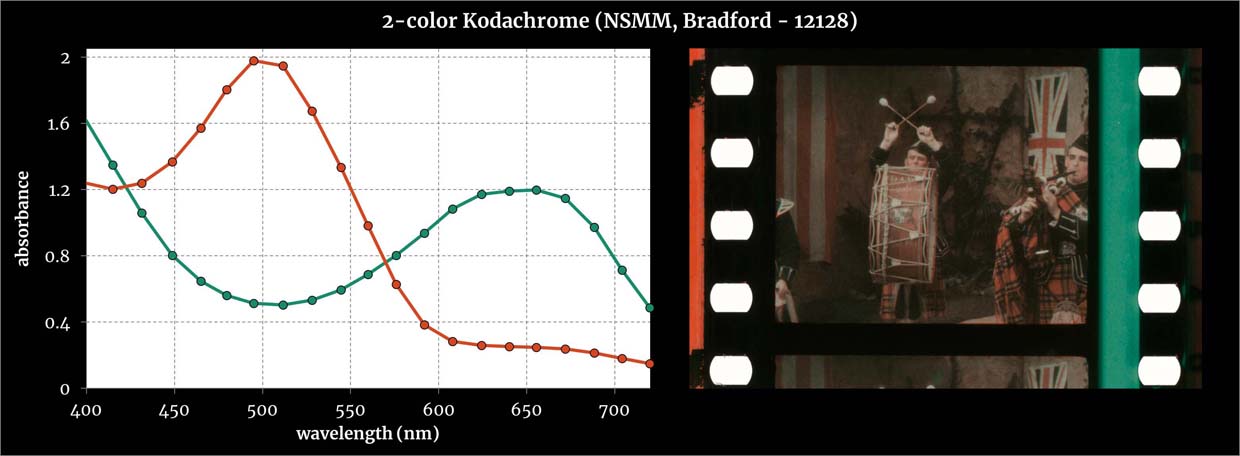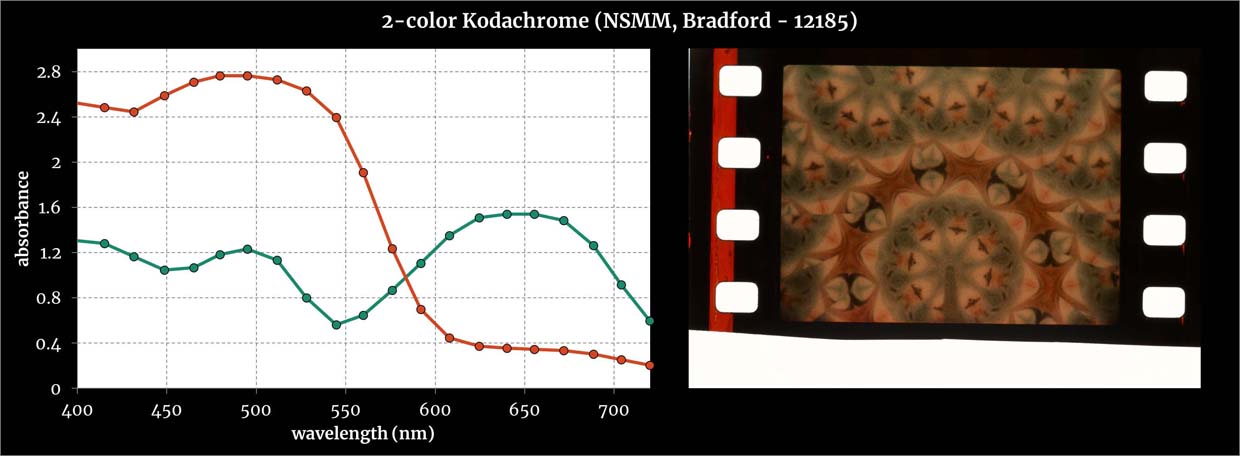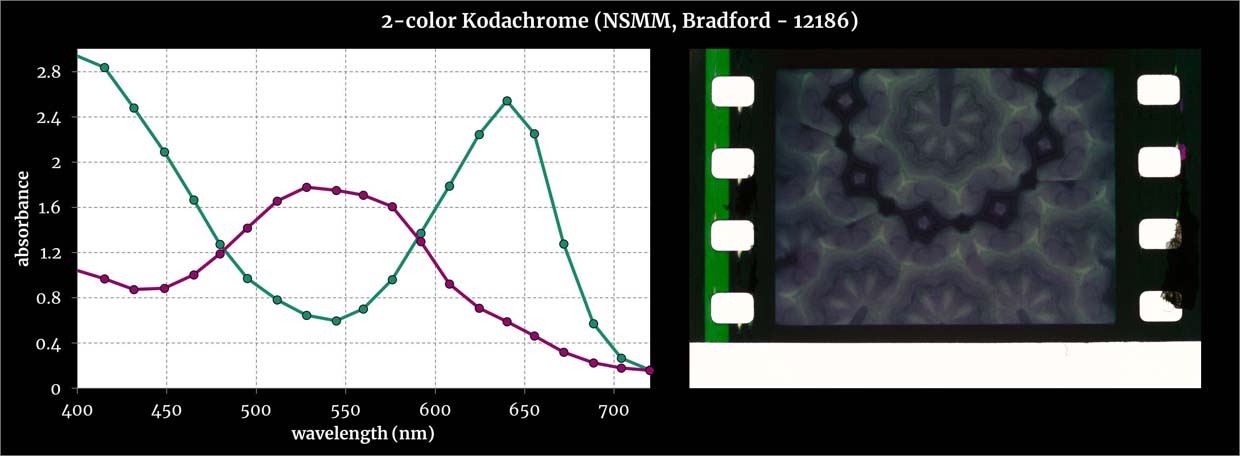Kodachrome Two-color 1915, after 1930 renamed Fox Nature Color
Description
The Kodachrome process was invented by John G. Capstaff in 1913 for still photography and subsequently adapted to motion pictures. For the process two frames were advanced simultaneously, one located above the other. The light passed either through two lenses or through a beam-splitter, fitted with red and green filters. From the camera negative a master-positive was produced on an optical printer. During this step, optical problems caused by the arrangement were also corrected. The release print was exposed through a beam-splitter whereby the alternate frames were projected onto either side of double-coated stock. After development by a usual b/w process, the film was tanned to harden the exposed areas. The soft areas were dyed red-orange and blue-green respectively.
Due to the loss of light caused by the filters and by the optical set-up, the speed of the process was rather low.
-
![]()
Two-Color Kodachrome Print (USA ca. 1925 to 1927, Anonymous). Credit: George Eastman Museum. Photographs of the Kodachrome two-color double coated stock from 1925 and 1927 by Olivia Kristina Stutz, ERC Advanced Grant FilmColors.
-
![]()
Source: Eggert, John (1932): Kurzer Überblick über den Stand der Farbenkinematographie. In:Bericht über den VIII. Internationalen Kongress für wissenschaftliche und angewandte Photographie, Dresden 1931, pp. 214-222. Leipzig: J. A. Barth.
-
![]()
Magnification 5x. Credit: photomicrograph by Silvana Konermann.
-
![]()
Magnification 10x. Credit: photomicrograph by Silvana Konermann.
-
![]()
Magnification 20x. Credit: photomicrograph by Silvana Konermann.
-
![]()
Kodachrome Two-color test from 1922, YouTube channel of the George Eastman House.
Galleries Open all Galleries ▼
Original Technical Papers and Primary Sources
Anonymous (1916): The Kodachrome Process. In: The British Journal of Photography, Colour Supplement, 10, p. 234 View Quote and 485. View Quote
Kelley, William Van Doren (1925): Color Photography Patents (cont.). In: Transactions of the Society of Motion Picture Engineers, 24, Oct., pp. 149–161, on p. 156. View Quote, View PDF
Secondary Sources
Alt, Dirk (2011): “Der Farbfilm marschiert!” Frühe Farbfilmverfahren und NS-Propaganda 1933-1945. München: Belleville, on pp. 41–42. (in German) View Quote
Busch, L. (1930): Das Kodachrome-Verfahren. In: Die Kinotechnik, 12,11, Jun., pp. 312–313. (in German) View Quote
Dr. N. (1937): Mehrschichten-Film. In: Film-Kurier, 27.8.1937, Serie “Farb-Film-Fibel”. (in German) View Quote
Eggert, John (1932): Kurzer Überblick über den Stand der Farbenkinematographie. In: Bericht über den VIII. Internationalen Kongress für wissenschaftliche und angewandte Photographie, Dresden 1931. Leipzig: J. A. Barth, pp. 214–221, on pp. 215–218. (in German) View Quote
Guiralt Gomar, Carmen (2014): Two-color Kodachrome and Its Incorporation at The Light in the Dark (Clarence Brown, 1922). First and Only One Public Exhibition of This Experimental Process in a Commercial Feature. In: Fotocinema, 9, pp. 83–116, on pp. 91–97 View Quote and on pp. 109–115. (in Spanish) View Quote
Ives, F.E. (1930): Something More About Progress in Subtractive Process Color Cinematography. In: Transactions of the Society of Motion Picture Engineers, 15, pp. 211–212. View Quote
Klein, Adrian Bernhard = Cornwell-Clyne (1940): Colour Cinematography. Boston: American Photographic Pub. Co.. 2nd revised edition, pp. 14. View Quote
Koshofer, Gert (1996): Early Colorfilm Processes for the Cinema. In: Monica Dall’Asta, Guglielmo Pescatore and Leonardo Quaresima (eds.): Il colore nel cinema muto. Bologna: Clueb, p. 43. View Quote
Koshofer, Gert (1965): Jubiläum für einen Farbfilm. 30 Jahre Kodachrome. In: FM, 9, pp. 40–42, on p. 40. (in German) View Quote
Layton, James; Pierce, David (2015): The Dawn of Technicolor. Rochester: George Eastman House, on p. 59 View Quote, on pp. 61–62 View Quote, on p. 63 View Quote and on p. 180. View Quote
Layton, James (n.d.): Two-Color Kodachrome Test Shots No. III. In: Library of Congress National Film Preservation Board, n.p. View Link
Matthews, Glenn E. (1930): A Motion Picture Made in 1916 by a Two-Color Subtractive Process. In: Journal of the Society of Motion Picture Engineers, 15,5, 1930, pp. 624-626. View Quote
Mees, C.E. Kenneth (1929): The Processes of Color Photography. III. Color Cinematography. In: The Journal of Chemical Education, 6, pp. 44–51, on p. 48. View Quote
Nowotny, Robert A. (1983): The Way of All Flesh Tones. A History of Color Motion Picture Processes, 1895-1929. New York: Garland Pub., p. 152. View Quote
Ryan, Roderick T. (1977): A History of Motion Picture Color Technology. London: Focal Press, pp. 66 ff. View Quote
Pierotti, Federico (2012): La seduzione dello spettro. Storia e cultura del colore nel cinema. Genova: Le Mani-Microart, on p. 129. (in Italian) View Quote
Measurements

Absorbances measured with a multispectral imaging system from film areas with pure dyes. Credit: Giorgio Trumpy, ERC Advanced Grant FilmColors.
See the specific sample from which the spectra were measured.

Absorbances measured with a multispectral imaging system from film areas with pure dyes. Credit: Giorgio Trumpy, ERC Advanced Grant FilmColors.
See the specific sample from which the spectra were measured.

Absorbances measured with a multispectral imaging system from film areas with pure dyes. Credit: Giorgio Trumpy, ERC Advanced Grant FilmColors.
See the specific sample from which the spectra were measured.

Absorbances measured with a multispectral imaging system from film areas with pure dyes. Credit: Giorgio Trumpy, ERC Advanced Grant FilmColors.
See the specific sample from which the spectra were measured.
Loyd A. Jones Kaleidoscope (mid-1920s), sample from the National Science and Media Museum, Bradford (UK).
Absorbances measured with a multispectral imaging system from film areas with pure dyes. Credit: Giorgio Trumpy, ERC Advanced Grant FilmColors.
See the specific sample from which the spectra were measured.
Loyd A. Jones Kaleidoscope (mid-1920s), sample from the National Science and Media Museum, Bradford (UK).
Absorbances measured with a multispectral imaging system from film areas with pure dyes. Credit: Giorgio Trumpy, ERC Advanced Grant FilmColors.
See the specific sample from which the spectra were measured.
Kodachrome Two-color, 1920s. Credit: Gert Koshofer Collection. Sample No. 58. Photograph by Barbara Flueckiger.
Absorbances measured with a multispectral imaging system from film areas with pure dyes. Credit: Giorgio Trumpy, ERC Advanced Grant FilmColors.
See the specific sample from which the spectra were measured.
Kodachrome Two-color, 1920s. Credit: Gert Koshofer Collection. Sample No. 58. Photograph by Barbara Flueckiger.
Absorbances measured with a multispectral imaging system from film areas with pure dyes. Credit: Giorgio Trumpy, ERC Advanced Grant FilmColors.
See the specific sample from which the spectra were measured.
Films
Concerning $1000 (USA 1916, Anonymous)1
Flute of Krishna, produced in 1926 2
[Kaleidoscope] see notes on the film by restoration expert Daniela Currò 2
1 Koshofer, Gert (1965): Jubiläum für einen Farbfilm. 30 Jahre Kodachrome. In: FM, 9, pp. 40–42, on p. 40. (in German) View Quote
2 Guiralt Gomar, Carmen (2014): Two-color Kodachrome and Its Incorporation at The Light in the Dark (Clarence Brown, 1922). First and Only One Public Exhibition of This Experimental Process in a Commercial Feature. In: Fotocinema, 9, pp. 83–116, on pp. 109–115. (in Spanish) View Quote
Downloads
(1916) The Kodachrome Process. In: The British Journal of Photography, Colour Supplement, 10, 30-31, pp. 234, 485.)
Download PDFMatthews, Glenn E. (1930): A motion picture made in 1916 by a two-color subtractive process. In: Journal of the Society of Motion Picture Engineers, 15,5, 1930, pp. 624-626.
Download PDFKelley, William Van Doren (1925): Color Photography Patents (cont.). In: Transactions of the Society of Motion Picture Engineers, 24, Oct., pp. 149–161.
Download PDF
Patents
E.P. 13,429 (Capstaff, John George; filed Sept. 21, 1915; granted June 15, 1916)
Download PDFU.S.P. 1,196,080 (Capstaff, John George; filed Sept. 21, 1914; granted Aug. 29, 1916)
Download PDFU.S.P. 1,273,457 (Capstaff, John George; filed Jan. 6, 1917; granted July 23, 1918)
Download PDFU.S.P. 1,351,834 (Capstaff, John George; filed March 29, 1918; granted Sept. 7, 1920)
Download PDFU.S.P. 1,394,504 (Capstaff, John George; filed April 5, 1920; granted Oct. 18, 1921)
Download PDFU.S.P. 1,469811 (Capstaff, John George.; filed July 12, 1922; granted Oct. 9, 1923)
Download PDFU.S.P. 1,478,599 (Capstaff, John George; filed Sept. 21, 1914; granted Dec. 25, 1923)
Download PDF
Links
Notes on the film [Kaleidoscope] by restoration expert Daniela Currò
Layton, James (n.d.): Two-Color Kodachrome Test Shots No. III. In: Library of Congress National Film Preservation Board, n.p. View Link
Contemporary Reception
Anonymous (1926): Ein Farbenfilm nach dem Kodachrome-Verfahren. In: Die Kinotechnik, 8,10, p. 270. (in German) View Quote



















